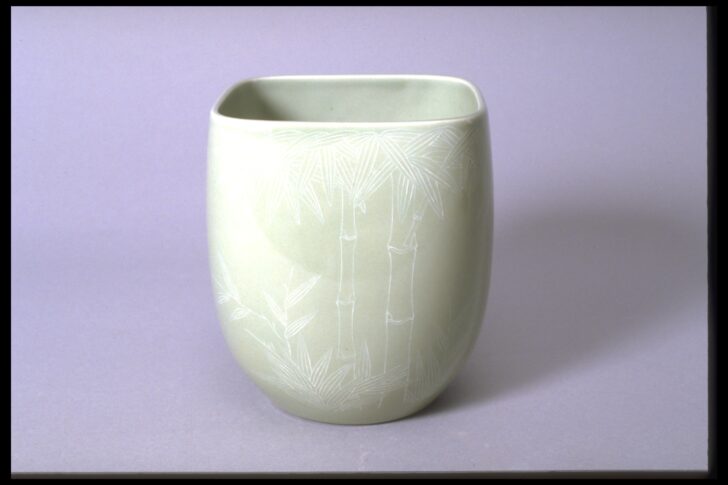Water jar
Seifū Yohei III

Description
A mizusashi is a container for the fresh cold water that is used to replenish a kettle during the practice of wabi tea, which finds elegance in rusticity. Along with a tea bowl and a tea container, a mizusashi has been an important tea implement since the time of wabi tea pioneers in the sixteenth century. UMMA has a remarkable collection of mizusashi dating from the mid-Edo period to the contemporary period, and many were made by master potters in important tea ware kilns such as Raku, Seto, and Hirado.
The small red container was made by Raku Keinyû, who was in the eleventh generation of the Raku family lineage founded by Raku Chôjirô (d. 1589), a Chinese immigrant potter who collaborated with influential tea master Sen no Rikyû (1522–1591). This Raku mizusashi is hand-built rather than wheel-thrown, and roughly chiseled using bamboo tools. The resulting irregularity is the epitome of the rustic wabi tea aesthetic. Such wares were often collected and used alongside porcelain wares, such as Hirado ware, a smooth, painted ware commonly given as gifts to the ruling Tokugawa shogunate (military government) and daimyos (feudal lords). The contrast between these two types of wares was highly valued in the wabi tea aesthetic. Two pieces highlight the peristance of these two types of tea wares. The Meiji period virtuoso potter Seifû Yohei III’s elegant mizusashi is decorated with fine bamboo stalks made by incising the outlines of the bamboo in leather-hard clay, and then filling them with a white slip. Nakazato Takashi’s footed water jar, with its squat, bottom heavy form, floppylooking protruding handles, and thickly rimmed lid, pays homage to Momoyama period (1583–1615) models. But while Karatsu ware is normally evenly glazed, Nakazato has allowed the ash glaze to puddle and form brown streaks.; Seifû Yohei III
Japanese, 1854–1914
Mizusashi (water jar) with inlaid bamboo design
Meiji period (1868–1912)
circa 1893–1914
Porcelain with celadon glaze and inlaid white slip design
Bequest of Margaret Watson Parker, 1954/1.515A&B
Subject Matter:
A mizusashi is a container for the fresh cold water that is used to replenish a kettle during the practice of wabi tea, which finds elegance in rusticity. Along with a tea bowl and a tea container, a mizusashi has been an important tea implement since the time of wabi tea pioneers in the sixteenth century. UMMA has a remarkable collection of mizusashi dating from the mid-Edo period to the contemporary period, and many were made by master potters in important tea ware kilns such as Raku, Seto, and Hirado.
Usage Rights:
If you are interested in using an image for a publication, please visit https://umma.umich.edu/request-image/ for more information and to fill out the online Image Rights and Reproductions Request Form.